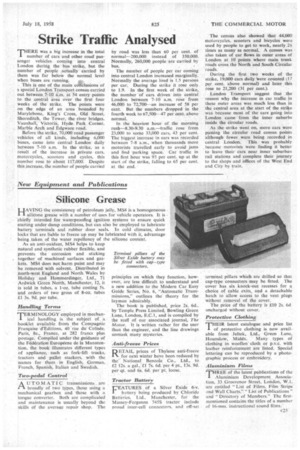Strike Traffic Analysed
Page 63

If you've noticed an error in this article please click here to report it so we can fix it.
THERE was a big increase in the total number of cars and other roadpassenger vehicles coming into central London during the bus ' strike, but the number of people actually carried by them was far below the normal level when buses are running.
This is one of the main conclusions of a special London Transport census carried Out between 7-10 a.m. at 54 entry points to the central area over the first four weeks of the strike. The points were on the edge of an area bounded by Marylebone, King's. Cross, Old Street, Shoreditch, the Tower, the river bridges, Vauxhall, Victoria, Hyde Park Corner, Marble Arch. and Edgware road.
Before the strike, 70,000 road passenger vehicles of all kinds, including 6,000 buses, came into central London daily between 7-10 a.m. In the strike, as a result of the increase in private cars, motorcycles, scooters and cycles, this number rose to about 117,000. Despite this increase, the number of people carried by road was less than 60 per cent, of normaI-200,000 instead of 350,000. Normally, 260,000 peopk are carried by bus.
The number of people per car coming into central London increased marginally. Normally the average load is 1.5 persons per car. During the strike. it rose only to 1.9. In the first week of the strike, the number of cars driven into central London between 7-10. a.m. rose from 46,000 to 72,700—an increase of 58 per cent. But the numbers dropped in the fourth week to 67,500,-47 per cent. above normal.
in the heaviest hour of the morning rush—&30.930a.m.—traffic rose from 23,000 to some 33,000 cars, 43 per cent. The biggest increase in cars was recorded between 7-8 a.m., when thousands more motorists travelled early to avoid jams and find -parking space. Car traffic in this first hour was 93 per cent, up at the start of the strike, falling to 65 per cent. at the end.
The census also showed that 44,000 motorcycles, scooters and bicycles were used by people to get to work, nearly 2+ times as many as normal. A census was also taken of car flows in outer areas of London at 10 points where main trunk roads cross the North and South Circular roads.
During the first two weeks of the strike, 19,000 cars daily 'Were counted t.t 7 per cent, above normal) and -later this rose to 21,200 (31 per cent.).
London Transport suggest that the reason why the increase in car traffic in these outer areas was much less than in the central area at the start of the strike was because most of the cars going into London came from the inner suburbs inside the Circular roads.
As the strike went on, more cars were passing the circular road census points although fewer were being recorded in central London. This was probably because motorists were finding it better to leave their cars near inner suburban rail stations and complete their journey to the shops and offices of the West End and City by train.












































































































